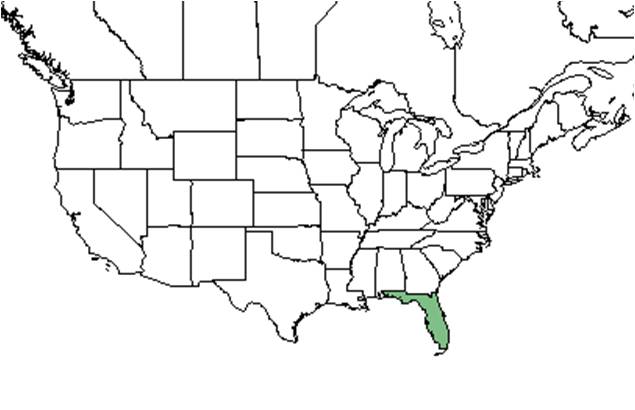Difference between revisions of "Sabal etonia"
Krobertson (talk | contribs) (→Distribution) |
Krobertson (talk | contribs) |
||
| Line 31: | Line 31: | ||
==Ecology== | ==Ecology== | ||
===Habitat=== <!--Natural communities, human disturbed habitats, topography, hydrology, soils, light, fire regime requirements for removal of competition, etc.--> | ===Habitat=== <!--Natural communities, human disturbed habitats, topography, hydrology, soils, light, fire regime requirements for removal of competition, etc.--> | ||
| − | In the Coastal Plain in Florida, ''Sabal etonia'' occurs in sand pine/oak scrubs<ref name="fsu">Florida State University Robert K. Godfrey Herbarium database. URL: http://herbarium.bio.fsu.edu. Last accessed: November 2015. Collectors: K.M. Meyer, A. Townesmith. States and Counties: Florida: Putnam. Compiled by Tall Timbers Research Station and Land Conservancy.</ref> | + | In the Coastal Plain in Florida, ''Sabal etonia'' occurs in sand pine/oak scrubs.<ref name="fsu">Florida State University Robert K. Godfrey Herbarium database. URL: http://herbarium.bio.fsu.edu. Last accessed: November 2015. Collectors: K.M. Meyer, A. Townesmith. States and Counties: Florida: Putnam. Compiled by Tall Timbers Research Station and Land Conservancy.</ref> Associated species include ''Pinus clausa, Ceratiola ericoides,'' and ''Quercus ilicifolia''. Grows in well-drained sandy soils and entisols.<ref name="abrahamson2009">Abrahamson, W. G. and C. R. Abrahamson (2009). "Life in the Slow Lane: Palmetto Seedlings Exhibit Remarkable Survival but Slow Growth in Florida's Nutrient-Poor Uplands." Castanea 74(2): 123-132.</ref> |
===Phenology=== <!--Timing off flowering, fruiting, seed dispersal, and environmental triggers. Cite PanFlora website if appropriate: http://www.gilnelson.com/PanFlora/ --> | ===Phenology=== <!--Timing off flowering, fruiting, seed dispersal, and environmental triggers. Cite PanFlora website if appropriate: http://www.gilnelson.com/PanFlora/ --> | ||
Revision as of 11:40, 18 August 2016
| Sabal etonia | |
|---|---|

| |
| Photo by Shirley Denton (Copyrighted, use by photographer’s permission only), Nature Photography by Shirley Denton | |
| Scientific classification | |
| Kingdom: | Plantae |
| Division: | Magnoliophyta - Flowering plants |
| Class: | Magnoliopsida – Dicotyledons |
| Order: | Arecales |
| Family: | Arecaceae ⁄ Palmae |
| Genus: | Sabal |
| Species: | S. etonia |
| Binomial name | |
| Sabal etonia Swingle ex Nash | |

| |
| Natural range of Sabal etonia from USDA NRCS Plants Database. | |
Common name: scrub palmetto
Contents
Taxonomic notes
Description
A description of Sabal etonia is provided in The Flora of North America.
S. etonia has a subterranean stem that is S-shaped or contorted, with the crown bud held below the soil surface.[1] This species resembles Serenoa repens, however, S. repens has a true palmate leaf with no midrib and sawlike teeth along the edges of the petiole.[2]
Distribution
S. etonia only occurs naturally in the well drained sandy ridges in peninsular Florida.[2] It is distributed in Florida from Clay county south to Lake Okeechobee and then along the east coast south to Miami-Dade county.[3]
Ecology
Habitat
In the Coastal Plain in Florida, Sabal etonia occurs in sand pine/oak scrubs.[4] Associated species include Pinus clausa, Ceratiola ericoides, and Quercus ilicifolia. Grows in well-drained sandy soils and entisols.[5]
Phenology
Flowers in spring. Fruits are shiny black berries[1].
Seed bank and germination
This species is extremely long lived and experiences limited recruitment of slow-growing seedlings. Both seedlings and adults can persist in drought and wildfire. Seedlings display a type 2 survivorship with constant mortality rates[5].
Fire ecology
S. etonia displays strong postfire flowering responses, this is typical of many monocots[6]. It is very tolerant to fire[7].
Pollination
The following Hymenoptera families and species were observed visiting flowers of Sabal etonia at Archbold Biological Station: [8]
Apidae: Apis mellifera, Bombus pennsylvanicus, Epeolus floridensis, Mellisodes communis, Nomada fervida
Colletidae: Colletes distinctus, C. mandibularis, C. sp. A, Hylaeus confluens
Halictidae: Agapostemon splendens, Augochlorella aurata, Augochloropsis anonyma, A. metallica, Lasioglossum miniatulus, L. nymphalis, L. placidensis, Sphecodes heraclei
Megachilidae: Coelioxys sayi, Megachile albitarsis, M. brevis pseudobrevis, M. mendica, M. texana
Pompilidae: Paracyphonyx funereus
Sphecidae: Cerceris blakei, C. flavofasciata floridensis, Epinysson basilaris, Isodontia exornata, Oxybelus decorosum, Stictiella serrata
Vespidae: Euodynerus boscii boharti, Leptochilus alcolhuus, Mischocyttarus cubensis, Monobia quadridens, Pachodynerus erynnis, Parancistrocerus bicornis, P. salcularis rufulus, Stenodynerus beameri, S. oculeus
Use by animals
Fruits are eaten by birds[1].
Diseases and parasites
Individuals are susceptible to scale, mites and leaf skeletonizers[9].
Conservation and management
Cultivation and restoration
Photo Gallery
References and notes
Florida State University Robert K. Godfrey Herbarium database. URL: http://herbarium.bio.fsu.edu. Last accessed: November 2015. Collectors: K.M. Meyer, A. Townesmith. States and Counties: Florida: Putnam. Compiled by Tall Timbers Research Station and Land Conservancy.
- ↑ 1.0 1.1 1.2 [[1]]University of Florida Extension. Accessed: March 10, 2016
- ↑ 2.0 2.1 [[2]]Floridata. Accessed: March 15, 2016
- ↑ [[3]]Regional Conservation. Accessed: March 15, 2016
- ↑ Florida State University Robert K. Godfrey Herbarium database. URL: http://herbarium.bio.fsu.edu. Last accessed: November 2015. Collectors: K.M. Meyer, A. Townesmith. States and Counties: Florida: Putnam. Compiled by Tall Timbers Research Station and Land Conservancy.
- ↑ 5.0 5.1 Abrahamson, W. G. and C. R. Abrahamson (2009). "Life in the Slow Lane: Palmetto Seedlings Exhibit Remarkable Survival but Slow Growth in Florida's Nutrient-Poor Uplands." Castanea 74(2): 123-132.
- ↑ Abrahamson, W. G. (1999). "Episodic Reproduction in Two Fire-Prone Palms, Serenoa repens and Sabal etonia (Palmae)." Ecology 80(1): 100-115.
- ↑ [[4]]Palmpedia. Accessed: March 16, 2016
- ↑ Deyrup, M.A. and N.D. 2015. Database of observations of Hymenoptera visitations to flowers of plants on Archbold Biological Station, Florida, USA.
- ↑ [[5]]Missouri Botanical Gardens. Accessed: March 18, 2016